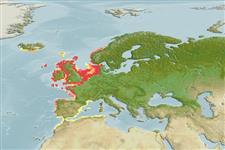Bivalvia |
Venerida |
Mactridae
Environment: milieu / climate zone / djupintervall / distribution range
Ekologi
; djupintervall 0 - 60 m (Ref. 106944). Subtropical, preferred 10°C (Ref. 107945); 65°N - 32°N, 24°W - 12°E
Eastern Atlantic and the Mediterranean: From southern Iceland to North Sea, Morocco and Madeira to the Mediterranean.
Length at first maturity / Size / Weight / Age
Könsmognad: Lm ? range ? - ? cm Max length : 5.0 cm SHL hane/ej könsbestämd; (Ref. 7882); rapporterad maxålder: 13 år (Ref. 106244)
Depth based on occurrence (Ref. 2758, p. 805); to be replaced with better reference. Minimum depth from Ref. 2703. Species' maximum length from the Belgian part of the North Sea (Ref. 7882). Found along the coasts and further out into the open sea, mainly on top of sea banks. Shallowly burrows in coarse-grained sediment. A suspension feeder (Ref. 7882).
Life cycle and mating behavior
Könsmognad | Reproduktion | Lek | Eggs | Fecundity | Larvae
Members of the class Bivalvia are mostly gonochoric, some are protandric hermaphrodites. Life cycle: Embryos develop into free-swimming trocophore larvae, succeeded by the bivalve veliger, resembling a miniature clam.
Gaspar, M.B., M.N. Santos and P. Vasconcelos 2001 Weight-length relationships of 25 bivalve species (Mollusca: Bivalvia) from the Algarve coast (southern Portugal). J. Mar. Biol. Ass. U.K. 81:805-807. (Ref. 2758)
IUCN Red List Status
(Ref. 130435: Version 2025-1)
CITES status (Ref. 108899)
Not Evaluated
Not Evaluated
Threat to humans
Human uses
Fiskeri: kommersiell
FAO - fiskeri: landings | FishSource | Sea Around Us
Verktyg
Ytterligare information
PhysiologySyreförbrukning
Human RelatedStamps, coins, misc.
Internet-källor
Estimates based on models
Preferred temperature
(Ref.
115969): 8.6 - 12.5, mean 10.4 (based on 344 cells).
Resiliens
Hög, lägsta populationsfördubblingstid mindre än 15 månader (K=0.23-0.43; tm=1; tmax=13).
Fishing Vulnerability
Moderate vulnerability (37 of 100).
Climate Vulnerability
High to very high vulnerability (71 of 100).
Nutrients : Calcium = 149 [71, 228] mg/100g; Iron = 8.53 [1.95, 15.11] mg/100g; Protein = 9.88 [8.64, 11.12] %; Omega3 = 0.313 [0.202, 0.423] g/100g; Selenium = 61 [50, 72] μg/100g; VitaminA = 0 μg/100g; Zinc = 2.04 [0.56, 3.51] mg/100g (wet weight); based on
nutrient studies.
